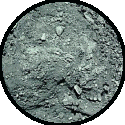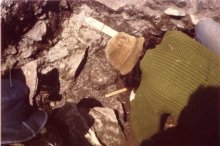

Excavation on the "Old French Graveyard", situated within the walls of Fort Louis, began on Wednesday, May 31, 1972. During this dig there were many artifacts found including wooden frames, bricks, pipe stems, etc. Artifacts believed to be part of the Fort Louis Complex. At 27 inches below the surface, a yellowish-brown stain was uncovered in the soil. It felt very soft and rubbery to the touch, this stain proved to be the right side of the skull vault. Using popsicle sticks, excavation began very slowly around the skull, trying at the same time to uncover some of the features of the skull. The skull was found to be resting on a large, rectangle rock that was tilted on its edges. The skull was badly compressed being only half an inch thick with the nasal cavity and the eye orbits obliterated. The vault was not uncovered since is was covered with a layer of soil and any attempts to remove this soil, even with popsicle sticks, caused bits of the bone to tear away.
 It was attempted to work down the chest area and uncover the vertebrate,
however, these were in bad shape, having lost all their external shape and though present, was not much more
then a blackish-brown stain in the soil. The right humerus (the upper arm) was located without
too much difficulty. It was followed six inches into the edge of the pit, where it had been cut off
by a backhoe when the Jerseyside water line was put in.
It was attempted to work down the chest area and uncover the vertebrate,
however, these were in bad shape, having lost all their external shape and though present, was not much more
then a blackish-brown stain in the soil. The right humerus (the upper arm) was located without
too much difficulty. It was followed six inches into the edge of the pit, where it had been cut off
by a backhoe when the Jerseyside water line was put in.
The discovery of the skeleton proved to be bad since, large numbers of children had gathered around and there was the possibility of damage being done. Photographs were taken and as much of the skeleton that could be safely removed, was removed.
Once the skeleton had been safely dealt with, work proceeded to see if the rocks under and around the skeleton were placed there purposely. At 27 inches below the surface, we found large rocks across the floor as were found under the skeleton. They were possibly part of the foundations of the English fort that was once situated in this area.
Joe O'Keefe's Interview by Carmel Wyse, May 24, 1972.
Mr. O'Keefe told the story of a ship coming into Placentia with sick soldiers and burying their dead in the "old burial ground". He said that there were probably six or seven burials. There were stones sticking out of the ground but these were probably destroyed.
Jim and Peter Mansfield's interview by Carmel Wyse, May 24, 1972.
They believe the burial ground is a 50 by 50 foot square in the corner of the ballfield, that is, inside the fence in the senior ballfield. He remembers the stones being there. Peter recalls digging up bones as a youngster. Jim says that the stones were visible up until about 20 years ago. He told us the same story told to us by Joe O'Keefe about the ship with the sick soldiers. He said that his grandmother actually saw it happen when she was a young girl. (She died in 1925 at the age of 95) The sickness on the ship was believed to be smallpox. Some of the dead were supposed to have been buried on an island in Dunville called "Blackman Island".
Cathy Kemp's interview by Carmel Wyse and Jim Wyse, May 24, 1972.
She agrees in the general with the stories given. She can remember seeing the outline of the graves in what she always thought of as the "French Graveyard". She believes that the graveyard was next to the pond that is now covered in. She belives that the house which she now lives in is situated on the site of an "Old French Hospital". She describes it as being long and narrow. On Mount Pleasent she tells us that there are possible graves.
Pictures of the dig at the Fort Louis Site.